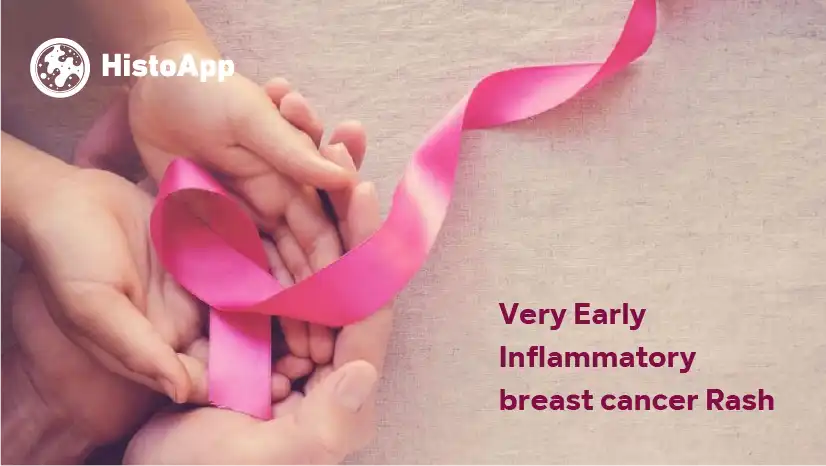


20 Mar 2025
The sudden appearance of a rash can be alarming, particularly for a patient of cancer or those with a history of the disease.
In the realm of breast health, recognizing the subtle signs of inflammatory breast cancer (IBC) is crucial, as early detection significantly impacts prognosis. 1 A seemingly innocuous rash, often dismissed as a simple skin irritation, can be a critical indicator of this aggressive form of cancer.
Understanding the nuances of IBC rashes, and the vital role played by the pathology laboratory in diagnosis, is paramount. This article delves into the characteristics of very early IBC rashes, exploring how a thorough examination within the pathology lab can differentiate them from benign conditions, ultimately guiding timely intervention and improving patient outcomes.
Breast cancer is a type of cancer that develops in the cells of the breast, typically in the milk ducts (ductal carcinoma) or lobules (lobular carcinoma). It is one of the most common cancers affecting women worldwide, though it can also occur in men. The disease arises when abnormal cells in the breast grow uncontrollably, forming a tumor that can spread to other parts of the body if not detected and treated early.
Early detection is crucial for effective treatment, and recognizing the clinical signs of breast cancer can save lives. Common symptoms include:
If any of these signs are noticed, it is essential to consult a healthcare professional for further evaluation.
Advancements in technology have revolutionized the way breast cancer is diagnosed. Digital pathology plays a significant role by digitizing tissue samples and allowing pathologists to analyze them using high-resolution images. This technology enhances accuracy, enables remote consultations, and facilitates faster diagnosis, which is critical for timely treatment.
The pathology lab is at the heart of breast cancer diagnosis. Here, tissue samples from biopsies or surgeries are examined under a microscope to determine the presence of cancerous cells.
Pathologists analyze the samples to identify the type, grade, and stage of breast cancer, which guides the treatment plan. Modern pathology labs are equipped with advanced tools, including digital pathology systems, to ensure precise and efficient diagnostics.

Breast cancer is not a single disease but a group of conditions that can vary significantly in their behaviour, treatment, and prognosis. Understanding the types of cancer is essential for accurate diagnosis and effective treatment. Here are the main types of breast cancer:
Accurate diagnosis of these types of cancer relies heavily on advanced technologies like pathology software and digital pathology. These tools allow pathologists to analyze tissue samples with greater precision, share digital slides for second opinions, and store data efficiently. Digital pathology also enables remote diagnostics, which is particularly beneficial for patients in underserved areas.
The pathology laboratory is where the critical work of diagnosing breast cancer takes place. Pathologists examine tissue samples under microscopes, often aided by pathology software, to determine the type and stage of cancer. This information is vital for developing a personalized treatment plan for each patient of cancer.
Understanding the various types of cancer is crucial for effective treatment. Leveraging technologies like pathology software and digital pathology, along with the expertise of a pathology laboratory, ensures accurate diagnosis and better outcomes for every patient of cancer.

Inflammatory breast cancer (IBC) is a rare and aggressive form of breast cancer that often presents with unique symptoms, particularly in its early stages. One of the hallmark signs of early-stage IBC is a rash that resembles an infection or skin irritation. Key characteristics of this rash include:
Unlike other kinds of cancer diseases, IBC does not typically present as a distinct lump, making it harder to detect through traditional methods like mammograms. If these symptoms are observed, immediate medical evaluation is crucial.
Breast cancer is categorized into stages of cancer based on the size of the tumour, its spread to lymph nodes, and whether it has metastasized to other parts of the body. The stages range from 0 to IV:
The chances of being cured depend on several factors, including the stage of cancer, the type of breast cancer, and the patient’s overall health. Early detection significantly improves outcomes, as treatment is most effective in the initial stages of cancer. For example:
Inflammatory breast cancer, being one of the more aggressive kinds of cancer diseases, requires prompt and aggressive treatment. Despite its rapid progression, early detection and a multidisciplinary approach to treatment can improve outcomes.

In the MENA region, the fight against breast cancer faces unique challenges, particularly in early detection and accessibility to specialized diagnostics. That’s where HistoApp steps in, revolutionizing the landscape as the first-of-its-kind mobile pathology solution in the MENA region.
Imagine having the power of expert breast cancer diagnosis at your fingertips. HistoApp empowers patients and healthcare providers alike, making the crucial step of early detection easier and more reachable than ever before.
Gone are the days of lengthy waits and geographical barriers. HistoApp streamlines the process, connecting patients with certified pathologists through a secure and user-friendly platform. Through high-resolution image analysis and cutting-edge AI, HistoApp facilitates rapid, accurate diagnoses, bridging the gap between patients and specialized expertise.
This innovative application breaks down traditional barriers, ensuring that timely breast cancer detection is no longer a privilege, but a readily available resource for every woman in the MENA region. HistoApp: empowering women, one diagnosis at a time.
Read More About:
Cancer Therapy
Digital Cancer
digital pathology

- OR -
You can make us a free call through our website, press the button below and start the call
Call Us now